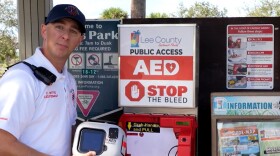TALLAHASSEE --- A national COVID-19 “dashboard” released Wednesday by AARP shows that the death rate of Florida nursing-home residents over a recent four-week period exceeded the national average.
The AARP online site, which looks at nursing-home data for four weeks ending Sept. 20, shows that 1.38 of every 200 nursing home residents in Florida died from COVID-19. Nationally, about one out of every 200 nursing home residents died from COVID-19.
Also, the rate of infected nursing-home residents in Florida was 4.5 percent, compared to 2.6 percent nationally. Moreover, the rate of infected staff members in Florida nursing homes was 3.9 per 100 residents, exceeding the national average of 2.5 per 100 residents.
AARP Florida spokesman Dave Bruns said Florida is the “grayest” state in the nation. One in five residents is age 65 or older, or 20.4 percent of the population, compared to 13.4 percent nationally.
“If there is any place that should be focusing on this, it should be the Sunshine State.” Bruns told The News Service of Florida.
The AARP dashboard has national and state information and is based on data the nursing home industry reported to the federal Centers for Medicare & Medicaid Services for the four-week period between Aug. 24 and Sept. 20. That period included a Sept. 1 move by Florida to allow visitation to resume at nursing homes, after months of the facilities being locked down to prevent the spread of COVID-19.
The information compiled by AARP underscores continued work that needs to be done, Bruns said. Among other things, AARP Florida has said regular, rapid-result testing of staff members, residents, visitors and vendors should be mandatory at all elder-care facilities to prevent the spread of the virus.
“People are picking this virus up in restaurants, in bars, in social settings, at sporting events and other places. Then, the fear is that they will carry it into these facilities,” Bruns said. “Once it gets into these facilities, it is not uncommon for a quarter, sometimes even as much as half, of the people who are infected to die.”
Gov. Ron DeSantis’ office did not comment on the AARP information. But DeSantis has touted the state’s efforts to keep residents safe at Florida’s 694 nursing homes.
The administration, though, in the last month has reversed policies such as mandatory testing of all long-term care staff members and the use of specific facilities that cared for and isolated nursing-home residents with COVID-19.
The DeSantis administration also lifted the ban on visitors at long-term care facilities last month. While he acknowledged the move would increase COVID-19 cases, DeSantis said the need for visitation could no longer be ignored.
As of Wednesday, 6,136 long-term care residents were positive for COVID-19, according to state data. That figure includes residents of nursing homes, assisted living facilities and intermediate care facilities for people with developmental disabilities. Also, more than 6,300 residents and staff members of long-term care facilities have died from COVID-19. The overwhelming majority of those deaths involved residents, data show.
The AARP dashboard shows that Florida had a higher percentage of nursing homes with active cases of COVID-19 positive residents, 47 percent, than the national rate of 24 percent. And nearly 72 percent of Florida nursing homes reported staff infections from COVID-19, compared to about 48 percent nationwide
In a statement to the News Service, Florida Health Care Association spokeswoman Kristen Knapp said, “More can always be done to improve our state’s long term services and supports system for our seniors and individuals with disabilities.”
Knapp said the association, which represents nursing homes throughout the state, looks forward to working with AARP, among others, on “continued support to ensure the safety, care and well-being of our nursing home residents, their families and caregivers.”
Knapp also said that “99 percent of nursing home residents are COVID free and 98 percent of staff are COVID free.” She said that is based on state Department of Health information that excludes from consideration the numbers of positive nursing-home residents transferred out of facilities
In addition to increased testing to curb the spread of the virus, AARP has advocated for greater transparency of the public reporting of cases and deaths in facilities and called for increased accountability of how nursing homes spend state and federal Medicaid and Medicare dollars and CARES Act stimulus funding.
The AARP information showed that Florida.nursing homes fared better than the national average when it came to personal protective equipment. Nationally, 28 percent of nursing homes reported having less than a week’s worth of so-called PPE on hand during the four-week period. In Florida, 20 percent of the facilities reported having less than a week’s worth of protective gear.
--- News Service Assignment Manager Tom Urban contributed to this report.
Copyright 2020 WLRN 91.3 FM. To see more, visit . 9(MDAyMTYyMTU5MDEyOTc4NzE4ODNmYWEwYQ004))







